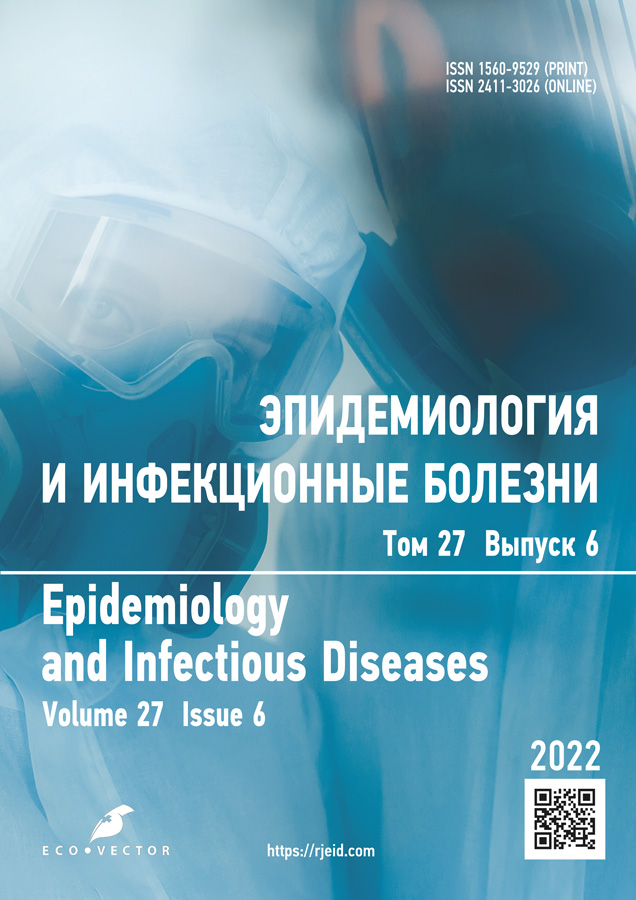Tuberculosis vaccination of young children during the COVID-19 pandemic: modern practices
- Authors: Minaeva V.A.1,2, Golubkova A.A.1,3
-
Affiliations:
- Russian Medical Academy of Continuing Professional Education
- Children’s City Polyclinic No. 86
- Central Research Institute of Epidemiology
- Issue: Vol 27, No 6 (2022)
- Pages: 333-340
- Section: Original study articles
- Submitted: 13.10.2022
- Accepted: 16.02.2023
- Published: 11.03.2023
- URL: https://rjeid.com/1560-9529/article/view/111867
- DOI: https://doi.org/10.17816/EID111867
- ID: 111867
Cite item
Abstract
BACKGROUND: Reducing population immunity to vaccine-controlled infections because of low vaccination coverage at any moment could destabilize earlier epidemiological well-being against vaccine-controlled infections in the context of the COVID-19 pandemic.
AIM: This study comprehensively assessed the completeness and timeliness of TB vaccination of young children in a maternity hospital-polyclinic stages and identified resources to improve their immunization.
MATERIALS AND METHODS: Form 063/in patients born from January 1, 2020, to December 31, 2021, (3613), Registers of newborns under the supervision of the Children’s City Polyclinic (DPP) from 2020 to 2021 were obtained (3). This article uses epidemiological (descriptive-estimative and analytical) and statistical methods of analysis using the online service StatTech. Electronic discharges from the EMIAS system were used to examine the timeliness and completeness of vaccination coverage.
RESULTS: In 2020 and 2021, because of the early discharge of newborns from the maternity hospital, a significant proportion of them were not vaccinated against tuberculosis within the timeframe prescribed by the National Immunization Prevention Calendar. In 2020, 24.8% of the causes of not contracting tuberculosis in a maternity hospital were discharged early, whereas, in 2021, it was 9.6% (p <0.05). In 2020, the chances of not vaccinating against BCG because of early withdrawal were 3.12 times higher than in 2021 (95% of confidence interval 2.09–4.7). In the structure of the causes of the lack of development, the largest proportion was medical withdrawals from BCG and parental refusals, 40.7% and 40.9%, respectively. In 2020 and 2021 their number was relatively stable, and for each of the analyzed items, more than 40%. Later on, only 32.8% of those not disabled in the maternity hospital were vaccinated against tuberculosis up to the age of 2 months. The cumulative coverage of tuberculosis vaccination for children registered with DHS was 82% by the first 12 months of life, which was not in line with the WHO target of 95% immunization coverage. The reasons for this failure were parents’ refusal to be vaccinated (48.5%), their low social responsibility (39.2%), and medical defenses (12.3%). The interruption of vaccination schedules at the maternity ward during the COVID-19 pandemic due to the early discharge of newborns resulted in a delay in scheduling subsequent vaccinations. As a result, children were born in 2020 and 2021. By 12 months, 17%, whooping cough, diphtheria, and tetanus, 20.6%, polio 20.5%, pneumococcal infection 30.2%, had not been vaccinated.
CONCLUSION: Given the high incidence of morbidity among children up to the age of two and the increase in the number of home-based cases of tuberculosis, the ambiguity of the situation makes vaccination against tuberculosis a priority in the current version of the National Immunization Service. It requires control of the regulated order of the Ministry of Health of Russia from December 6, 2021. 1122h “On approval of the national calendar of preventive vaccinations, the calendar of preventive vaccinations according to epidemic indications and the order of preventive vaccinations” calendar.
Full Text
About the authors
Viktoria A. Minaeva
Russian Medical Academy of Continuing Professional Education; Children’s City Polyclinic No. 86
Author for correspondence.
Email: minaevava@zdrav.mos.ru
ORCID iD: 0000-0002-2434-6706
Postgraduate Student
Russian Federation, Moscow; MoscowAlla A. Golubkova
Russian Medical Academy of Continuing Professional Education; Central Research Institute of Epidemiology
Email: allagolubkova@yandex.ru
ORCID iD: 0000-0003-4228-9044
SPIN-code: 6133-2572
MD, Dr. Sci. (Med.), Professor
Russian Federation, Moscow; MoscowReferences
- On the state of sanitary and epidemiological well-being of the population in the Russian Federation in 2020: state report. Moscow: Federal Service for Supervision of Consumer Rights Protection and Human Welfare; 2020. 256 p. (In Russ).
- World Health Organization report on global tuberculosis control 2021 [Internet]. Available from: https://www.who.int/ru/news/item/14-10-2021-tuberculosis-deaths-rise-for-the-first-time-in-more-than-a-decade-due-to-the-covid-19-pandemic. Accessed: Feb 16, 2023. (In Russ).
- Tsybikova EB, Punga VV, Rusakova LI. Tuberculosis with concurrent HIV infection in Russia: statistics and correlations. Tuberculosis and Lung Diseases. 2018;96(12):9–17. (In Russ). doi: 10.21292/2075-1230-2018-96-12-9-17
- Skornyakov SN, Chugaev YuP, Kamaeva NG, et al. Clinical and epidemiological features of tuberculosis in HIV-infected children in the Sverdlovsk region. Ural Medical Journal. 2013;(2):116–120. (In Russ).
- On the state of sanitary and epidemiological well-being of the population in the Russian Federation in 2019: state report. Moscow: Federal Service for Supervision of Consumer Rights Protection and Human Welfare; 2019. 300 p. (In Russ).
- Bogorodskaya EM, editor. Antituberculosis work in Moscow during the COVID-19 pandemic (2020). Moscow: Sputnik+; 2021. 277 p. (In Russ).
- Feldblyum IV, Devyatkov MYu, Alyeva MK. Vaccination of Newborns in Obstetric Institutions as an Indicator of the Quality of Medical Care for Babies. Epidemiology and Vaccinal Prevention. 2020;19(2):48–55. (In Russ). doi: 10.31631/2073-3046-2020-19-2-48-55
- Aksenova VA, Sevostyanova TA. Neonatal vaccination against tuberculosis under present-day conditions: Significance and problems. Russian Bulletin of Perinatology and Pediatrics. 2015;60(1):100–103. (In Russ).
- Kuznetsova OA, Golubkova AA, Bashmakova NV. Modern Practices of Vaccination of Children from Perinatal Risk Groups and Necessary Precaution. Epidemiology and Vaccinal Prevention. 2020;19(5):98–103. (In Russ). doi: 10.31631/2073-3046-2020-19-5-98-103
- Kuznetsova OA, Golubkova AA, Bashmakova NV. Conditions, determining timeliness of newborn vaccination at perinatal center. Perm Medical Journal. 2019;36(5):52–57. (In Russ). doi: 10.17816/pmj36552-57
- Platonova TA, Koltunova ES, Golubkova AA, et al. Practical issues of vaccination of children in a polyclinic (based on expert assessment of vaccination in indicator groups). Pacific Medical Journal. 2018;(3):33–37. (In Russ).
- Vasilyeva IA, Testov VV, Sterlikov SA. Tuberculosis Situation in the Years of the COVID-19 Pandemic — 2020–2021. Tuberculosis and Lung Diseases. 2022;100(3):6–12. (In Russ). doi: 10.21292/2075-1230-2022-100-3-6-12
Supplementary files







